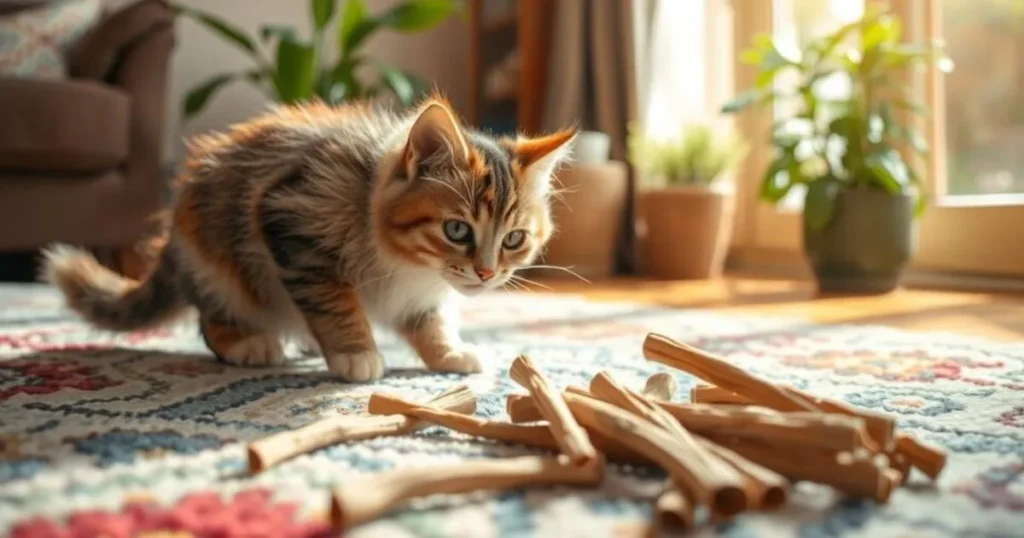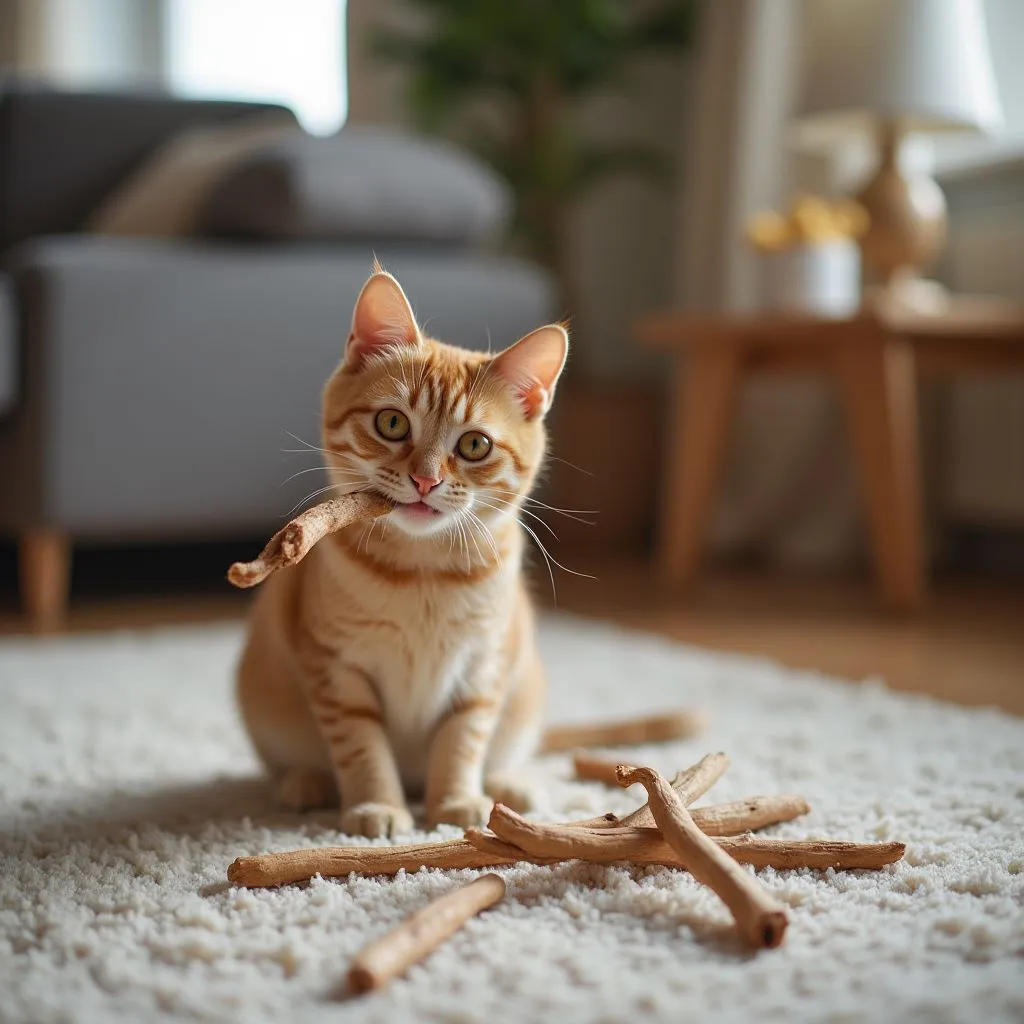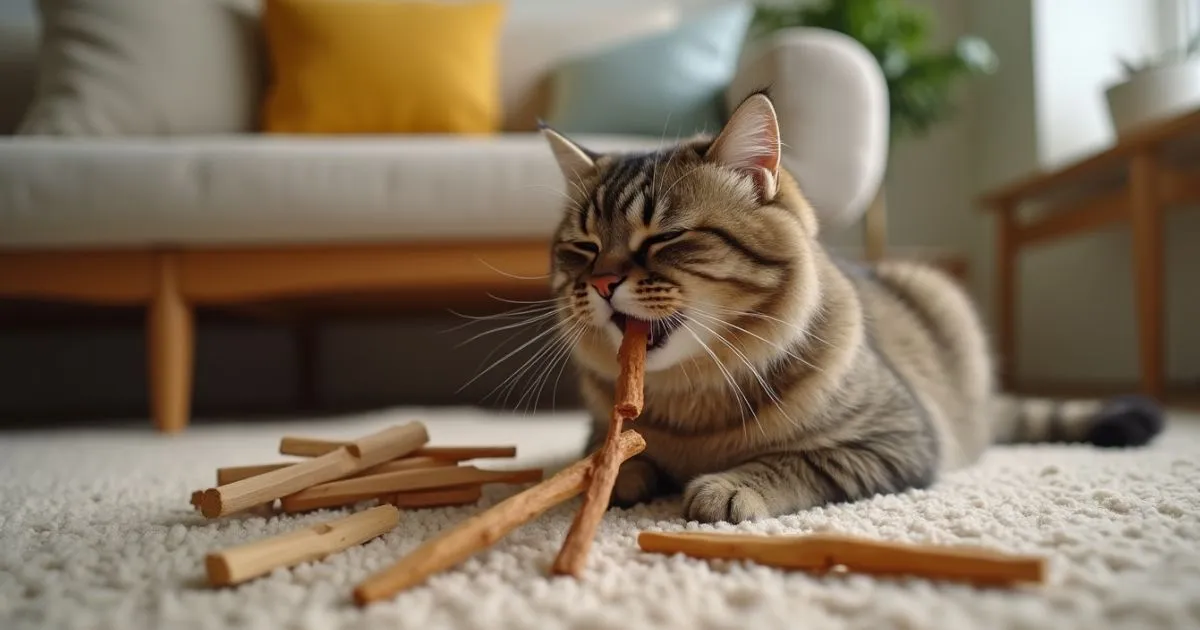As pet owners, we must understand our cats’ behavior, especially with treats like Silvervine chew sticks. These sticks are fun for cats but swallowing them can worry us. We’ll look into why cats do this, the risks and benefits, and how to keep them safe while enjoying Silvervine.
Table of Contents
Key Takeaways
- Silvervine is a natural, catnip-like substance that many cats find irresistible.
- Cats may swallow silvervine chew sticks due to their natural instinct to chew and play.
- Responsible usage and supervision are important to prevent potential health risks.
- Recognizing the signs of excessive Silvervine consumption can help you address the issue promptly.
- Exploring alternative safe chewing options can provide your cat with similar stimulation.
Understanding Silvervine Sticks and Their Appeal to Cats
As cat owners, you might have seen your pets get excited about silvervine. This natural plant is a big hit with many pet owners. It’s a special substance that’s different from catnip.
Chemical Compounds in Silvervine
Silvervine’s charm comes from its active part, actinidine. It works with cats’ sense of smell in a way similar to catnip. Although silvervine and catnip differ, both bring joy and playfulness to cats.
Natural Alternative to Catnip
If you’re looking for something other than catnip, silvervine is a great choice. Cats who don’t like catnip can still have fun with silvervine. It’s a special way to make playtime more interesting for your cat.
Why Cats Love Silvervine
Cats love silvervine for many reasons. The smells in silvervine make their brains buzz with excitement. It makes them more alert, playful, and even relaxed. Silver vine cat toys are an excellent option for keeping your feline engaged and amused.

The Safety of Silvervine Sticks for Feline Consumption
Many pet owners worry about the safety of silvervine sticks for cats. The health of our feline friends is very important. Let’s explore what experts say about silvervine and its effects on cat health.
Research shows that silvervine, or Actinidia polygama, is usually safe for cats. It contains compounds like actinidine and dihydroactinidiolide. These are not toxic to cats when used correctly.
But, it’s important to use silvervine sticks responsibly. Giving them too much or using them wrong can upset a cat’s stomach. It might cause minor problems in some cats.
To keep your cat safe, do the following:
- Start with small amounts of silvervine sticks and watch how your cat reacts.
- Don’t let your cat eat too many silvervine sticks. This can cause problems.
- Watch your cat when they play with silvervine sticks. This prevents choking or eating too much.
- Keep silvervine sticks away from curious cats when not in use.
By following these tips, you can add silvervine sticks to your cat’s fun routine. They can enjoy the special smell and feel of these natural treats.
Why Do Cats Swallow Silvervine Chew Sticks?
Cats are drawn to silvervine chew sticks for many reasons. Their natural instincts, behavior, and environment play a big part. Knowing why they swallow these treats helps pet owners manage their cats better.
Natural Instincts and Chewing Behavior
Cats are born to chew, which keeps their teeth and gums healthy. It also lets them shred and tear objects. The smell of silvervine sticks makes cats want to chew and swallow them.
Behavioral Factors
Some cats swallow silvervine sticks because of their behavior. Cats that are constantly swallowing or swallowing hard might be stressed, anxious, or bored. They chew and swallow silvervine to find comfort or excitement.
Environmental Influences
Where a cat lives affects their chance of swallowing silvervine sticks. Indoor cats or those with little outdoor time might swallow more silvervine. They try to meet their hunting and chewing needs indoors. Also, having silvervine sticks around can encourage cats to chew and swallow them.
Signs Your Cat is Consuming Too Much Silvervine
Silvervine sticks can be a fun and natural treat for your cat. However, it’s crucial to monitor and limit their use appropriately. Too much silvervine can cause health problems. Watch for these signs that your cat might be eating too much:
- Excessive Licking or Chewing – If your cat is spending too much time on the sticks, it’s a sign they might be eating too much.
- Digestive Issues – If your cat is vomiting, has diarrhea, or constipation, it could mean they’re eating too much silvervine.
- Loss of Appetite – If your cat suddenly doesn’t want to eat, it might be because they’re eating too much silvervine.
- Lethargy or Drowsiness – If your cat is unusually tired or sleepy, it could be a sign they’ve had too much silvervine.
Should you notice any concerning symptoms, consult your veterinarian immediately. They can check for health problems and make sure your cat is okay. It’s important to watch how much silvervine your cat eats and to supervise them when they have it.
| Symptom | Potential Cause | Action Recommended |
|---|---|---|
| Excessive Licking or Chewing | Overconsumption of silvervine | Reduce access to silvervine, consult vet |
| Digestive Issues | Excessive silvervine intake | Limit silvervine, monitor for improvement, consult vet |
| Loss of Appetite | Imbalance due to too much silvervine | Adjust silvervine dosage, encourage regular diet, consult vet |
| Lethargy or Drowsiness | Overconsumption of silvervine | Reduce silvervine access, observe for other changes, consult vet |
By watching for these signs and adjusting your cat’s silvervine, you can make sure they enjoy it safely. This way, your cat can have fun without any health risks.
Health Benefits and Risks of Silver vine for Cats


Understanding the benefits and risks of Silver Vine for Cats is key. It’s a natural option instead of catnip. But, it’s important to make sure it’s safe for them.
Positive Effects on Cat Behavior
Silvervine can make cats more playful and happy. Many cat owners see their pets acting more energetic and joyful after using silvervine. It can also help reduce stress and make cats feel more relaxed.
Potential Health Concerns
Silvervine is usually safe for cats in small amounts. But, eating too much can cause stomach problems like vomiting or diarrhea. Rarely, it might also harm the liver or kidneys if cats get too much of it.
| Health Benefit | Potential Health Risk |
|---|---|
| Improved mood and relaxation | Gastrointestinal issues (vomiting, diarrhea) |
| Stimulating and energizing effect | Liver or kidney problems (with prolonged exposure or high doses) |
| Reduced stress and anxiety | Possible allergic reactions in some cats |
Keep an eye on how much silvervine your cat eats. Talk to your vet if you’re worried about its effect on your cat’s health.
How to Choose Safe Silvervine Sticks for Your Cat
Choosing the right silvervine sticks for your cat is important. Silvervine is a natural option that can keep your cat happy and engaged. Here’s how to pick the best silvervine sticks for cats that are safe and fun for them.
Source from Reputable Brands
Start by looking for silvervine sticks from trusted brands. These brands usually have strict quality checks. They make sure their products are safe and free from harmful stuff.
Inspect the Ingredients
Check the ingredients on the silvervine stick packaging. Make sure it only has natural silvervine. Stay away from products with synthetic smells or colors.
Look for Organic and Non-GMO Options
Choose silvervine sticks for cats that are organic or non-GMO. These labels mean the product is made without many chemicals.
Prioritize Responsible Sourcing
Find silvervine sticks from suppliers who care about the environment. This ensures the silvervine is harvested in a way that’s good for the planet and the plants.
By following these tips, you can find the best silvervine sticks for cats. They will make your cat happy and safe.
Proper Usage and Supervision Guidelines
Using silvervine sticks with your cat needs careful attention to keep them safe. It’s important to know how much to give and watch how they play. This ensures they enjoy their time without any harm.
Recommended Dosage
Give silvervine sticks in small amounts to avoid health issues. A practical guideline is to allow your cat brief play sessions lasting only a few minutes. Limit it to a few times a day to keep them safe.
Monitoring Tips
- Watch your cat closely when they play with silvervine sticks. Make sure they don’t swallow them.
- Stop using them if your cat seems uncomfortable. Look for signs like too much drooling, vomiting, or feeling very tired.
- Keep silvervine sticks away when not in use. This prevents your cat from accidentally eating them.
- If you’re worried about your cat and silvervine sticks, talk to your vet.
By watching your cat and following these tips, you can make playtime with silvervine sticks fun and safe. This way, you ensure your cat stays happy and healthy.
| Recommended Dosage | Monitoring Tips |
|---|---|
| Limit exposure to a few minutes per session No more than a few sessions per day | Observe your cat’s behavior closely Discontinue use if signs of discomfort appear Store silvervine sticks safely when not in use Consult your veterinarian if you have concerns |
When to Contact Your Veterinarian
Silvervine chew sticks can be a fun treat for your cat. But, it’s important to watch how much they eat and when to get vet help. Cats that swallow hard or constantly swallow might have a health problem.
See your vet if you notice these signs:
- Your cat swallows a lot or seems uncomfortable while chewing on the silvervine stick
- Your cat eats too much silvervine, which could cause stomach issues
- Your cat has vomiting, diarrhea, or doesn’t want to eat
- Your cat acts differently, like being more upset or aggressive, after eating silvervine
Your vet can tell you how much silvervine is safe for your cat. They can also check for any health problems that might be causing your cat to swallow hard or constantly swallow.
Your cat’s health is the most important thing. By talking to your vet, you can make sure your cat enjoys silvervine safely.
Alternatives to Silvervine Chew Sticks
While silvervine can be a captivating chewing option for many cats, it may not be suitable for all feline companions. If your cat is sensitive to silvervine or you simply want to provide additional enrichment, there are several safe and engaging alternatives to consider.
Safe Chewing Options
Offer your cat a variety of safe chewing toys. Natural wood sticks, rawhide-free dental chews, or sturdy rubber toys are great. These alternatives can satisfy your cat’s need to chew without the potential risks associated with silvervine consumption.
Interactive Toy Alternatives
To mimic the stimulation of silvervine, introduce interactive toys. Treat-dispensing puzzles, interactive wands, and even simple cardboard boxes can provide hours of mental and physical engagement for your feline friend. Rotating these toys can keep your cat entertained and prevent boredom.
By offering a diverse array of safe and engaging alternatives, you can ensure your cat’s overall well-being. A happy and healthy cat is one that has access to a variety of enriching activities and stimuli.
FAQ
Do cats swallow silvervine chew sticks?
Yes, cats might swallow silvervine chew sticks because they enjoy the stimulating effects. This can be risky if not watched closely.
Are silvervine sticks safe for cats to consume?
Silvervine sticks are usually safe for cats in small amounts. But too much can be harmful. Always watch your cat and follow expert advice on how much to give.
Why do cats love silvervine so much?
Cats love silvervine because it has a compound called actinidine. This makes them feel happy and relaxed, just like catnip.
How can I tell if my cat is consuming too much silvervine?
Too much silvervine can make your cat drool a lot, vomit, or feel tired. If you observe unusual signs, contact your veterinarian promptly.
What are the potential health benefits and risks of silver vine for cats?
Silvervine can make cats more playful and relaxed. But too much can upset their stomach or heart rate. It’s best to give it in small amounts.
How can I choose safe and high-quality silvervine sticks for my cat?
Choose silvervine sticks from trusted brands with natural ingredients. Avoid sticks with chemicals and know where they come from.
How should I properly use and supervise my cat’s interaction with silvervine sticks?
Follow the maker’s dosage advice and watch your cat with silvervine sticks. Limit how often and for how long they use them. Always supervise your cat to prevent potential choking hazards.
When should I consult my veterinarian about my cat’s silvervine consumption?
Call your vet if your cat drools a lot, vomits, or has bowel changes. Or if you’re unsure about using silvervine.
Are there any alternatives to silvervine chew sticks for cats?
Yes, there are safe toys and activities like catnip toys and cardboard scratchers. These can keep your cat happy without the risks of too much silvervine.

